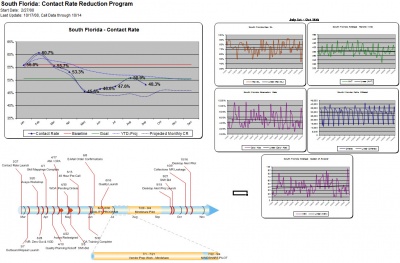Cost Improvement Programs
Contents
[hide]Cost Improvement Programs
Workforce Management organizations often are leveraged for establishing baseline metrics within a contact center and validating whether identified cost or metric improvement initiatives have yielded improvements in contact center operations. While 1:1 correlations are not always feasible, changes that are implemented and properly base-lined can be examined by a WFM organization to evaluate whether volumes, handle-time, shrinkage, or occupancy have changed as the result of that activity.
Below is a sample real-life contact rate reduction plan. In this plan, WFM would support validations of various segments.
Executive Summary
South Florida Region is currently experiencing a customer contact rate outside of normal operational goals and expectations. In order to determine the primary drivers contributing to the high contact rate, the Southern Division Customer Care and Technical Operations support team has launched a project to analyze all potential contributing factors. The project began with 3 weeks spent on-site in Florida, reviewing daily operations in both the call center and the field. This report outlines the initial observations, and recommends initiating a series of projects specifically designed to reduce contact rate within the call center.
Methodology
The methodology used to examine contact rate drivers approaches the business from multiple vantage points. Live and historical data collection, live customer care interactions and direct feedback from front-line representatives and management contributed to the core findings included in this report. The activities conducted to derive the initial findings included:
• Call Monitoring Sessions • Workforce Management Interviews • Supervisor Focus Group • CAE Focus Group • Resolve Ticket Analysis • Traffic Analysis (Live and Historical) • Analysis of Avaya VDN and Skill Structure • Outbound Repeat Caller Program (National Team)
No Single Cause
All observations and studies to this point suggest that there are at least 8 major contributing factors driving an increased contact rate. A critical observation; higher contact rate within the markets served by the Miramar call center is being driven by multiple causes. Contact rate solutions will require multiple initiatives, some of which will require significant change and investment in the operational environment. The 8 major call driver factors identified in this report include:
Avaya Call Routing & Skills
Finding: Avaya Structure Suspect – Analysis of the Avaya call routing structure, vectors, VDNs and skill design indicate a significant opportunity to improve call routing, and potentially directly lower contact rate. 2000+ VDNs feed over 100 active skills which lack a uniform method for accounting for call volume. Currently, the call center business is managed by altering VDNs and Vectors in a live environment, which introduces the potential for creating errors in call routing. An example of such an error was logged on March 3rd, when a return path VDN & Vector from an outsourcer, designed to hand calls back into the call center, was built with a vector that was set as “high” priority. This caused calls to flow freely from the outsourced vendor, but because of the large inbound volume, it at the same time created a call blocking situation:
